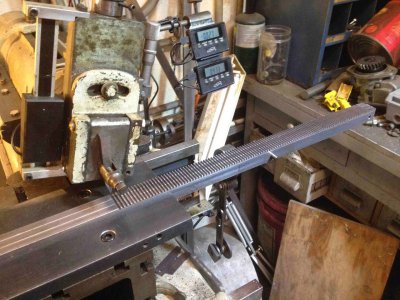I installed a set on my Logan shaper to aid in making a set of racks for a cmc plasma table.
The racks are 58 inches long with reamed holes every 8 inches. This was done on the milll using a different dro. I then made clamping plates out of 1 x 2 flat bar and drilled and reamed holes 8 inches apart of dowel pins to locate the rack material. Three racks were done at once.
I would cut 8 inches of teeth then index the material and pick up the last tooth using the dro. Its 20 diametral pitch so 0.157 inches per tooth so 369 teeth. When I was done I could flip one end for end and the teeth would all mesh perfectly, so they have to be repeatable. I just assembled the table and checked the movement. Based on the theoretical tooth spacing the machine was out 1/64th in 41 inches of movement. so fairly accurate. That would be 0.0003811 per inch. Pretty good for a dro under a hundred bucks.
View attachment 73156
Greg


